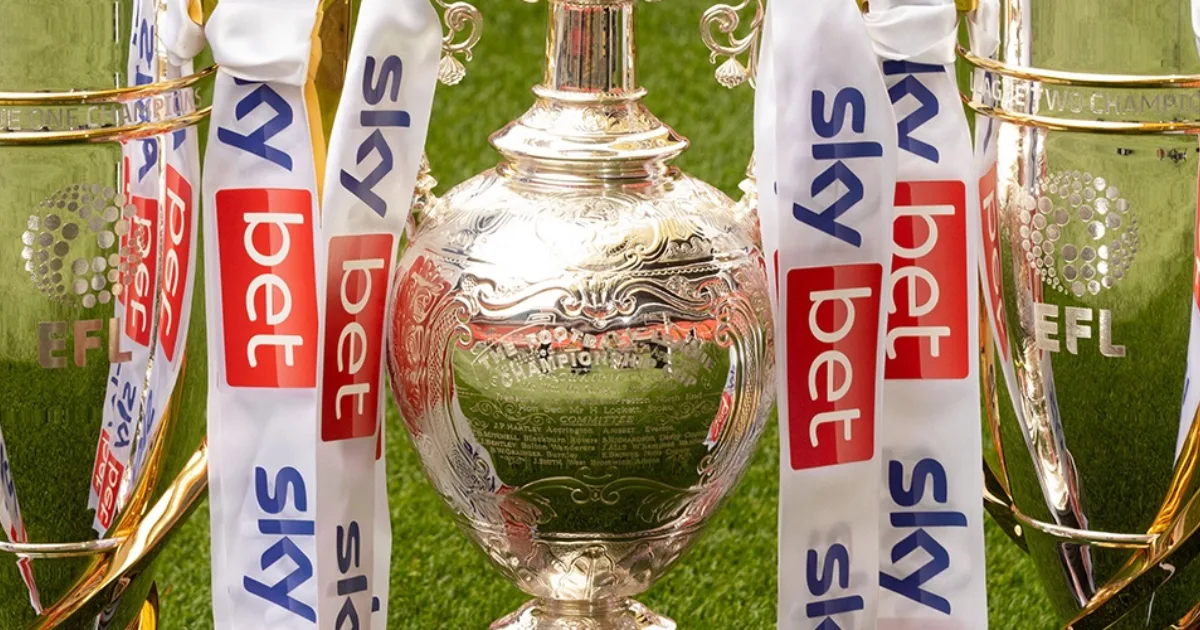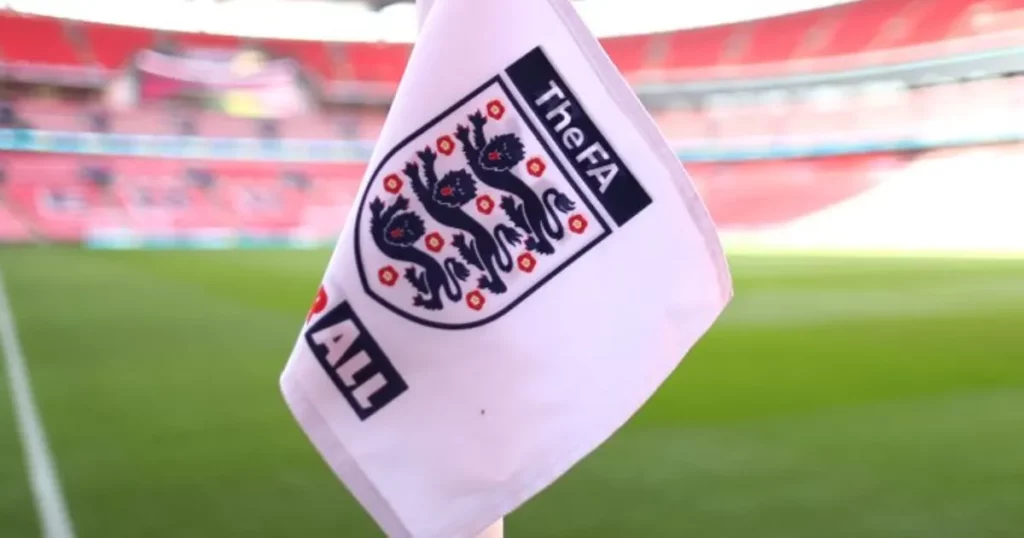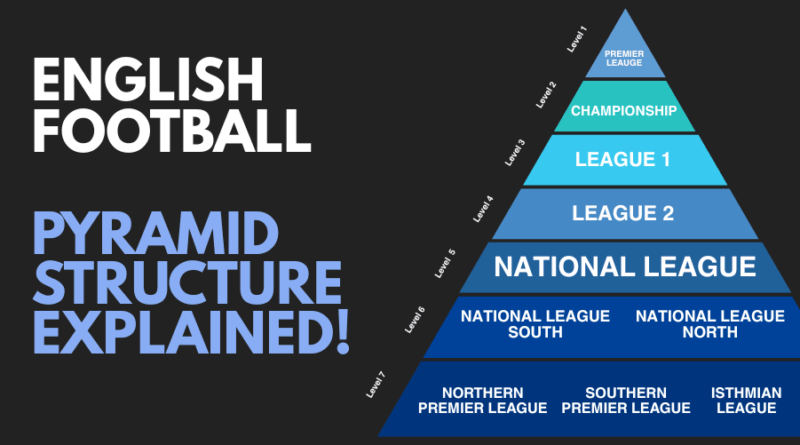English Football Pyramid Explained: Full Guide to the English football League System in 2025
What if we tell you that a small club from a single stand can play in the Premier League? Yes, you read that right, a village club can participate in the Premier League . Welcome to the most competitive yet captivating footballing system in the whole world. It is a structure that is built upon performance and not money, unlike some other commercial leagues, which ask for money or want clubs that have a long history. Every weekend, players from various fields, working players and non-working players gather together, taking hope in their eyes to make their team win and get promoted to the next level. As we step into 2025, the drama has only intensified. Clubs are rising faster, fans are louder, and the pyramid is proving itself more than just a league structure.
The English football pyramid forms the game’s roots in England with high competition across each division. The high level of fanfare for the sport is a testament felt not only by the biggest and most successful clubs in the land but also by the lower-division teams. Top-flight clubs with history like Manchester United, Liverpool, and Newcastle United, provide an enormous appetite for the game compared to the lower tiers. A large network of divisions is the foundation of the English football pyramid that makes up the country’s vibrant footballing landscape, covering everything from Premier League to county-level football that caters to audiences of various sizes.
What is the English Football Pyramid?
The English Football pyramid is one of the most complex league systems in the world. Often referred to football pyramid due to its tiered structure. It allows every kind of club to participate in it, whether a club having a seating capacity of 80,000 fans or an amateur side having a capacity of 10,000 to be part of this structure. At the top tier, we have teams like Manchester United, Liverpool, Arsenal, and many other famous teams. But just a few tiers below, there are hundreds of teams battling against each other on weekends to get closer to their Premier League dream. What makes this system truly unique is the idea that, in theory, any club can rise from the bottom of the pyramid to the very top through performance and merit alone. It’s a structure built on promotion and relegation, not franchises or fixed memberships.
The professional football structure is divided into four primary leagues: the Premier League, Championship, League One, and League Two. Before the induction of the Premier League in the 1992/93 season, there were just the First, Second, Third, and Fourth divisions. The introduction of the Championship in 2004 was a game-changer for both business and sport, marking the current system’s development. Collectively, the Championship, League One, and League Two form the English Football League (EFL), which traces its roots back to the 1888 English League. Although these clubs are entirely professional. The National League which includes the fifth tier also operates in a similar pattern, with the best example of Wrexham’s investment-driven success. Now, lets deep dive into the English football pyramid.
How Many Tiers are in the English Football League System?
Ask a die-hard English football fan what makes English football interesting and they will answer – the drama of relegation/promotion, plus the joy of watching your favourite team beat their arch rivals. But underneath it all lies the pyramid structure. The English football league system, often called the pyramid, isn’t just about the Premier League. It’s a vast, layered network where every club, from the elite to the unknown, has something to fight for. But just how many tiers are there? And how do they all connect?
In 2025, the network of football is growing in Great Britain – Professional, Semi-Professional, and Amateur Clubs, all of them together are moving towards a single dream that is league promotion. If you’ve ever wondered how a club can go from the tenth division to facing Manchester United in the FA Cup, or how deep the football obsession runs in towns you’ve never heard of, you’re about to find out below :-
Top Tier: The Premier League

Sitting firmly and comfortably at the top is the Premier League, where money, fame, and the elite clubs show their dominance. Arsenal, Manchester United Chelsea, Manchester City, Liverpool, and Tottenham Hotspur go heads on with each other for the biggest prize in the land. Manchester City under Pep Guardiola has been at the peak of its powers. In recent times they won five of the last six league titles. Needed to say the least, history sits close with local rivals Manchester United as they remain the successful side in the Premier League era. In the Sir Alex Ferguson era, the Red Devils were dazzling with their dominance, racking up a record 13 Premier League titles since 1992.
The Premier League remains one of the most popular football leagues in the world, reaching out to the world in 212 countries and 643 million homes. Technology and broadcast have increased the potential TV audience to 4.7 billion people. Celebrating a huge fanfare everywhere from the East to West and North to South, with top talents spanning from countries adding an extra essence making English football a spectacle.
Second to Fourth Tiers: The English Football League (EFL)

Beneath the top guns lie the Championship also known as England’s second tier. The standard of the game is extremely high as well, but it’s not on par with the Premier League. The major difference between the top two leagues in English football is the pay scale, while the Premier League provides payments to protect relegated clubs from financial turmoil. The parachute payments system was brought in in 2006 to provide a financial sum to the relegated teams from broadcasting revenue percentage for three years to reduce economic damage from losing their top-flight position.
League One and League Two at Tiers 3 and 4, continue the fully professional structure. While the currency drops here, the clubs only source of revenue here is ticket sales and merchandise of club. Compared to the Championship, these leagues are no less passionate and have enthusiastic fans here, like the Premier League. Many clubs here have rich histories, for example, Carlisle United and Bradford City, loyal fan bases, and strong local identities. Promotion and relegation across all three EFL tiers are straightforward the top teams go up, and the bottom clubs drop down, often into or out of the National League system.
Fifth to Eleventh Tiers: Non-League and Grassroots Football

At tier 5 National League is the highest non-league football division. While many teams here operate full time while other teams remain part-time in the league. We can say that this tier works as a bridge between Professional Footballers with Semi Semi-Professional and Amateur. Clubs in the National League are looking for a place in League Two, and many have a proud history, such as Wrexham AFC, which recently gained widespread attention. The league features 24 teams and, in 2025, remains fiercely competitive, with every club hoping for a place in the professional system. The teams relegated from the National League go down to Level 6 which consists of two regional leagues National League South and National League North. These leagues are connected to the top tier of non-league football with further leagues below.
At tier 6 league gets divided between two leagues – National League South & National League North. Each league consists of 22 teams and here fans can expect affordable tickets, a strong sense of identity, and a deeply passionate following. Clubs at these levels, often operating with small budgets, depend heavily on local talent and dedicated supporters.
At tiers 7-11, we can find amateur clubs with working professionals who usually play league games on weekends and try to promote their clubs to National League of their zone (South/ North). Despite having busy schedules, you can see grounds packed with supporters and family members of players. These leagues include the Northern Premier League, Southern League, and Isthmian League, among others.
Isthmian League is part of the seventh and eighth tiers of the English football pyramid and plays a significant role in the non-league structure. Founded in 1905, it primarily covers clubs from London, East, and South East England.
The reach of the English football league pyramid goes far beyond the well known leagues. With a huge number of over 2 million people participating in organized football in the UK alone, a figure higher than most of countries’ per capita basis, just shows the importance of the game.
Also Read: Raheem Sterling’s agents demand answers from Chelsea following exclusion from squad
Promotion and Relegation System in the English Football Pyramid

The promotion and relegation system is the key that makes this complex pyramid system enjoyable for the fans. It gives smaller clubs a chance to climb the ladder solely on the basis of their performances. At the top, the Premier League promotes three clubs from the Championship each season, the top two automatically, and the third via a four-team playoff. The same system applies between Championship and League One, and League One and League Two. (Note – 5 teams will qualify this time for the UEFA Champions League from the Premier League).
This type of structure not only keeps the leagues interested but also motivates players to perform well during each game to make their team qualify for the upper league. Let us have a look at how this promotion and relegation structure works for lower divisions and non-league levels.
Automatic Promotion and Playoffs (EFL & Non-League)
In English football, promotion to the next tier or division is earned and not given. And it comes in two forms, automatic and play-offs. Both Systems add layers of excitement and fairness to the game of football. rewarding consistent performance while giving underdogs a shot at glory.
In the EFL, the system is well structured. The Championship, League One, and League Two each promote three clubs per season. The top two teams in each division gain automatic promotion. Their league performance over 46 matches is enough to seal the deal. The third spot, however, is decided through a dramatic playoff (four-team mini-tournament involving the clubs finishing 3rd to 6th) or (4th to 7th in League Two). These playoffs, which play final at Wembley, often deliver some of the season’s most emotional moments that can be part of YouTube’s top 10 emotional moments in football videos.
In non-league football, automatic promotion also plays a key role, especially in the National League Tier 5 , where the champion goes up directly to League Two. The next six teams compete in a playoff for the second promotion slot. Lower down, in Tiers 6 to 8, promotion is more regionally managed but follows a similar format: top teams go up, and playoffs decide the remaining spots.
How Relegation Works Across Tiers
Every coin has 2 sides, if a few teams are getting promoted, there are a few teams who get relegated every season due to their poor performances or bad finances. While promotion brings joy to the team, relegation makes the players sad and demotivated.
In the Premier League, the bottom three teams at the end of the season are relegated to the Championship For example, after the 2024/25 season, Ipswich, Leicester City, and Southampton will get relegated to the Championship, taking with them a heavy financial blow. To soften the impact, these clubs receive parachute payments for a few seasons, helping them stay competitive and potentially bounce back quickly.
In the EFL, the same pattern continues in the 2nd to 4th tiers. The Championship and League One each see the bottom three teams relegated to the tier below. However, in League Two, only the bottom two teams face relegation to the National League, the highest level of non-league football.
In the non league system, from the National League down through Step 4, Tiers 5 to 8 , relegation is usually based on regional boundaries and the number of clubs within each league. For example, the bottom four clubs in the National League drop to National League North or South, depending on their location. From there, relegation becomes more regional and flexible, often involving one to two teams per division means either one or two teams will get promotion, or it may change, based on league restructuring needs.
List of English Football Pyramid Tiers
| Tier | League Name | No. of Teams | Promotion | Relegation |
|---|---|---|---|---|
| 1 | Premier League | 20 | Top 4 qualify for Europe, Bottom 3 relegated to EFL Championship | To Tier 2 (EFL Championship) – 3 teams |
| 2 | EFL Championship | 24 | Top 2 promoted automatically, 3rd–6th via playoffs | Bottom 3 to League One |
| 3 | EFL League One | 24 | Top 2 promoted automatically, 3rd–6th via playoffs | Bottom 4 to League Two |
| 4 | EFL League Two | 24 | Top 3 promoted automatically, 4th–7th via playoffs | Bottom 2 to National League |
| 5 | National League | 24 | Champion promoted, 2nd–7th via playoffs | Bottom 4 to National League North/South |
| 6 | National League NorthNational League South | 24 each | Champion promoted, 2nd–7th via playoffs (1 per division) | Bottom 4 (combined) to Step 3 leagues, geographically allocated |
| 7 | NPL Premier DivisionSouthern League Premier (C & S)Isthmian Premier | 22/league | Champion promoted, 2nd–5th via playoffs | 1–2 per division to Tier 8 leagues |
| 8 | NPL Division One (E/W)Southern Division One (C/S)Isthmian D1 (N/SC/SE) | 20/division | Champion promoted, 2nd–5th via playoffs | 1–2 per division to Tier 9 leagues |
| 9 | Regional Leagues (e.g. Combined Counties, United Counties) | 22/league | Promotion varies, generally 1 auto + playoffs | Relegation to Tier 10 local leagues |
| 10 | More Regional Divisions (e.g. Midland League Div One) | 16–20 | Promotion to Tier 9 based on performance + ground grading | Relegation to Tier 11 |
| 11 | County Leagues (e.g. West Yorkshire, Surrey Elite) | Varies | Promotion to Step 6 (Tier 10) | Bottom clubs may remain or drop to unaffiliated local football |
How the English Football Pyramid Impacts Club Finances and Growth

English football system is not just a complex network or structure of how football will work in Great Britain, but it also takes care of the finances of clubs. Each tier has its own fixed amount for clubs that will be participating in that tier. As clubs climb higher, they access significantly higher amounts of revenue from different kinds of rights like broadcasting, merchandise and others. These rights become the source of revenue for the club.
Promotion brings a huge financial boost, but also higher operational costs – better players, improved facilities, and more staff. For example, a club promoted from the Championship to the Premier League can see its revenue triple overnight. However, the risk is equally steep; relegation can lead to major cutbacks unless clubs have parachute payments or sustainable budgets in place.
At the lower levels, especially from the fifth tier/National League downwards, clubs operate with limited budgets. Here, success is often driven by community support, better recruitment, and strategic development. Grassroots clubs also benefit from FA funding and local partnerships, but growth tends to be slower and more dependent on volunteerism and passion. Players who are greedy or the members who just want money can’t survive in the lowest tiers of the pyramid.
Unique Features of the English Football League Pyramid System
With 11 interconnected tiers and thousands of teams, you might think Why all this chaos? The reason behind it is to encourage competition, with better competition, the best leagues will come above and play the Premier League, which gets broadcasted in almost every country. These kinds of rights bring more revenue and status to the league, indirectly helping to improve the country’s economy. The Premier League alone contributed £7.6 billion in 2019/2020. From the previous amount, you can guess the level of impact it has on a broader level. Additionally, this much competition gives players like Jude Bellingham, Phil Foden, and many more world-class players who are intended to help the national team win some international trophies.
Why England Has So Many Football Clubs
England has so many football clubs because of the sport’s deep historical roots and widespread community involvement. English football is is one of the oldest sports in the world. Football became popular in the late 19th century, and clubs began forming in nearly every town, school, and workplace. The English Football Pyramid allows even small, local teams to compete and progress to reach the highest level, where teams like Manchester City, Liverpool, and Arsenal are currently, encouraging the creation of new clubs over time. Strong local rivalries, which are called derbys, cultural identity, and the accessibility of football as a sport also contribute to its growth. From these many clubs, England gets their best 24-25 squad for international events – you can imagine how good the players are if they are getting picked by the National side.
The Role of FA and County Leagues in the Pyramid
The FA allocates funding, implements development programs, and sets facility requirements for clubs to progress through the system. This support is crucial for maintaining competitiveness and safety across every level, from the Premier League down to grassroots football. The Football Association (FA) plays a central role in maintaining the integrity and structure of the English football pyramid. It governs the overall framework, ensures consistency in regulations, and oversees promotion and relegation standards. This huge system works with no or fewer loopholes, meaning the FA is doing their work sincerely.
Also Read: Manchester United identify Atalanta star as an option to Manuel Ugarte
FAQs
What are the main football leagues in England?
The primary football leagues in England are the Premier League, Championship, League One, League Two and the National League.
How many games in the Championship?
A long season of 46 games for each of the 24 teams occurs in the Championship.
How many EFL teams get promoted?
In the Premier League, three teams get relegated every season, while in the Championship, three teams get relegated, and three get promoted every season.
What are the 9 tiers of English football?
The English football pyramid’s top 9 tiers include the Premier League, EFL Championship, League One, League Two, National League, National League North/South, and Northern Premier/Southern League Premier Central.
What is step 7 in English football?
Step 7 in English football refers to Tier 11 of the football pyramid, part of the National League System. It includes regional amateur leagues like the Northern League Division Two, Southern Combination Division One, and others.
How many levels in the English football pyramid?
The broader structure of the pyramid extends to around 20 levels in some regions, including local and county leagues below Tier 11, though these are less formally standardized.
What is the 5 tier of English football?
The fifth tier of English football is the National League, also known as the Vanarama National League.
